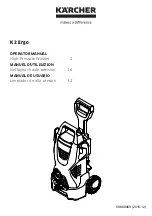
6
GB
Wash cycles
Table of wash cycles
Specials wash cycles
Mix 15’
(wash cycle 5) this wash cycle was designed to wash lightly soiled garments quickly: it lasts just 15 minutes and therefore
saves both energy and time. By selecting this wash cycle (5 at 30°C), it is possible to wash different fabrics together (except
for wool and silk items), with a maximum load of 1.5 kg.
Sanitizing cycle
(wash cycle 6). A high-temperature hygienic wash cycle (over 60°C) which requires the use of bleach. Pour the
bleach, the detergent and the additives into the relevant compartments (see paragraph entitled
“Detergent dispenser drawer”
).
Goodnigt cycle
(wash cycle 7). This is a silent cycle which can be run at night, when the electricity prices are lower. The wash cycle is
designed for cottons and synthetics. At the end of the cycle the machine stops while there is still water in the drum; to spin and drain the
laundry press the START/PAUSE button; alternatively the machine will perform the spin cycle and drain the water automatically after 8 hours.
Eco cycles
The Eco Cycles assure energy saving by eliminating the need of heating water and it’s an advantage both to
your energy bill and the environment! These innovative Eco programmes (Cotton
11
, Synthetics
12
and Fast
Wash
13
) are available for various fabrics and different quantity of garment; they have been designed to gua-
rantee a high cleaning action even at low temperature and can be used for lightly to medium soiled loads.
Eco Cycles give the best results thanks to an intensified wash action, water optimization and are carried out in the same ave-
rage time of a standard cycle. For the best washing results with Eco Cycles we recommend the usage of a liquid detergent.
W
ash cycles
Description of the wash cycle
Max.
temp.
(°C)
Max.
speed
(rpm)
Detergents
Max. load (kg)
Residual
dampness %
Energy con- sumption kWh T
otal water lt
Cycle duration
Pre-
wash
Bleach Wash
Fabric
softener
Essentials cycles
1
Prewash:
extremely soiled whites.
90°
1000
-
6
62
1,92 67 160
2
Cotton:
heavily soiled whites and resistant colours.
60°
1000
-
6
-
-
- 133
3
Coloured cottons (3):
lightly soiled whites and delicate colours.
40°
1000
-
6
62
0,65 54 92
4
Synthetics:
heavily soiled resistant colours.
60°
800
-
-
2,5
44
0,85 39 105
4
Synthetics (4):
lightly soiled resistant colours.
40°
800
-
-
2,5
44
0,53 39 95
5
Mix 15’:
to refresh lightly soiled garments quickly (not suitable for wool, silk
and clothes which require washing by hand).
30°
800
-
-
1,5
71
0,08 29 15
Special cycles
6
Sanitizing cycle:
extremely soiled whites.
90°
1000
-
6
-
-
- 182
6
Sanitizing cycle (1-2):
heavily soiled whites and resistant colours.
60°
1000
-
-
6
62 1,064 55 184
6
Sanitizing cycle (2):
lightly soiled whites and resistant colours.
40°
1000
-
-
6
62 1,014 66 173
7
Goodnight cycle:
lightly soiled delicate colours.
40°
800
-
-
4
-
-
- 282
8
Shirts
40°
600
-
-
2
-
-
-
80
9
Silk/Curtains:
for garments in silk and viscose, lingerie.
30°
0
-
-
1
-
-
-
56
10
Wool:
for wool, cashmere, etc.
40°
800
-
-
1
-
-
-
65
Eco cycles
11
Cottons
Cold
Water
1000
-
-
6
62
0,10 51 86
12
Synthetics
Cold
Water
800
-
-
2,5
48
0,07 27 68
13
Fast Wash
Cold
Water
800
-
-
2,5
71
0,04 34 30
Partials cycles
Rinse
-
1000
-
-
-
6
-
-
-
36
Spin
-
1000
-
-
-
-
6
-
-
-
16
Pump out
-
0
-
-
-
-
6
-
-
-
2
For all Test Institutes:
1) Test wash cycles in accordance with directives 1061/2010: set wash cycle 6 with a temperature of 60°C and 40°C.
This cycle is designed for cotton loads with a normal soil level and is the most efficient in terms of both electricity and water consumption; it
should be used for garments which can be washed at 60°C and 40°C. The actual washing temperature may differ from the indicated value.
2) Long wash cycle for cottons: set wash cycle 6 with a temperature of 40°C.
3) Short wash cycle for cottons: set wash cycle 3 with a temperature of 40°C.
4) Long wash cycle for synthetics: set wash cycle 4 with a temperature of 40°C.
The length of cycle shown on the display or in this booklet is an estimation only and is calculated assuming standard working conditions. The actual duration can vary accor-
ding to factors such as water temperature and pressure, the amount of detergent used, the amount and type of load inserted, load balancing and any wash options selected.







































